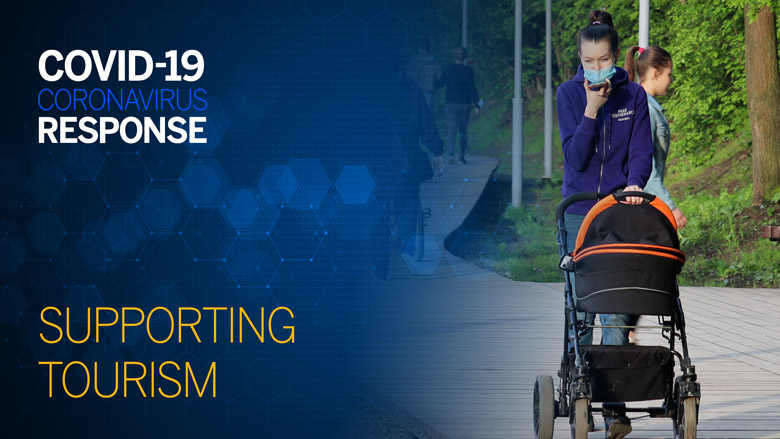
CHALLENGES
- The tourism industry is at a standstill. Even as policy makers around the world seek ways to mitigate the economic impact of the COVID-19 pandemic, the recovery of the tourism sector cannot begin until the health emergency is under control and travel restrictions can be safely lifted. The longer the health crisis lasts, the more difficult it will be for companies to survive, especially the small- and medium-sized enterprises (SMEs) that make up the lion’s share of the tourism ecosystem, and the greater the difficulties that tourism workers will face.
- The downturn in tourism will have a dramatic impact on a sector that represents 30 percent of the world’s service exports and 1 in every 10 jobs worldwide. The latest figures from the World Travel and Tourism Council, which represents the global travel and tourism industry, show that over 100 million jobs are at risk as global inbound tourism arrivals are expected to fall by 60–80 percent in 2020.
In Russia, estimates put the value of losses in the range of US$4 billion per quarter, with more than 400,000 jobs in travel and tourism at risk. This does not include the jobs indirectly linked to the tourism sector that are also impacted.
WHAT RUSSIA HAS DONE TO CONFRONT THESE CHALLENGES
Tourism is among the industries most affected by the crisis, making tourism companies eligible for a range of federal support programs.
Russia started to respond to the pandemic at the end of January 2020. The government’s anti-crisis measures adopted to date amount to roughly RUB 3.231 billion, or approximately 2.9 percent of GDP. Under these measures, tourism companies are eligible for loan and tax payment deferrals, zero interest rate loans to pay salaries, subsidized loans for other purposes, and subsidies for travel operators to refund payments to tourists and to bring tourists back from foreign countries due to the coronavirus outbreak.
Additional measures are being provided to support the aviation sector.
State aid will be provided to the aviation sector, with Russia’s Aeroflot group alone eligible for more than US$100 million in financial support. Other major airlines, including S7, UTair, and Ural Airlines, are also eligible for support. Data on Russia’s airline industry show that passenger traffic has declined by more than 90 percent compared to the previous year.
WHAT ARE OTHER COUNTRIES DOING?
It is difficult to know when a recovery will be possible. In the immediate term, governments and private companies are implementing crisis measures to protect the tourism industry as much as possible. Some examples include:
- Generating alternative revenues. Tourism destinations and the industry as a whole are considering innovative ways to maintain some revenue while discouraging travel. These include pay-it-forward voucher schemes, for example, the “I Love Manchester Scheme,” and “consume-at-home” content like virtual tours, destination audio-guides, restaurant- or hotel-branded online cooking, yoga, and/or spa classes, and restaurant delivery services.
- Providing for planning and communication. Destination communities and associations are forming virtual emergency response groups with the objective of maintaining a unified approach to the closure of attractions and promoting continued communication with trade buyers and consumers through social media. The best communication efforts should unequivocally focus on the health risks, case trends, and mitigation measures, such as Visit Copenhagen and Salzburg, Austria. Joint agreement on the most important requests from government, the financial sector, industry associations, and employee unions may also speed action.
- Informing the industry. Governments and associations can prepare advice and updates on the measures being taken to support the industry and/or its members and on how to access that support. For example, the website of the National Federation of Self-Employed and Small Businesses in the United Kingdom provides a comprehensive breakdown of all the assistance measures that are available.
- Reducing the tax burden. Governments are suspending or reducing income tax payments, business rates, and value added tax and other fees applied to businesses, including pay-as-you-earn deferrals and paid sick leave to provide relief to staff on reduced incomes. New Zealand has announced large-scale tax relief packages, and Myanmar has waived a 2 percent advanced income tax on exports.
- Planning for contamination support. Public financial support and/or supplies are being provided to businesses to manage the costs of physically dealing with the effects of the virus, such as deep cleaning services. An example is the Singapore Cleaning Support Fund for hotels.
- Providing liquidity. Governments, financial institutions, and other bodies are offering grants, funds, or alternative capital for those most at risk (such as SMEs—see, for example, the U.S. Small Business Administration’s response to the crisis) and extending lines of credit or working capital. To help reduce debt, banks are extending mortgage relief and deferrals on loan repayments.
- Redeploying assets. Destinations are examining opportunities to re-deploy staff or tourism assets to support the public health agenda, such as retraining flight attendants to support testing facilities or using hotels as health care facilities for low risk patients.
WHAT MORE COULD BE DONE?
Continue to support viable tourism businesses through the crisis.
The recovery of the tourism sector cannot begin until travel restrictions can be safely lifted. As of May 29, the World Tourism Organization reports that 100 percent of all destinations (217 destinations worldwide) continue to have COVID-19-related travel restrictions in place, and 75 percent of those remain completely closed to international tourism. In the interim period, businesses that depend on tourism will face growing pressures on their solvency, with some form of state support likely required to prevent widespread business closures and loss of jobs. This support could build on existing measures, such as subsidized lending and deferred loan payments and tax obligations, and/or include additional tools, such as the examples cited above on redeploying assets or providing liquidity support. Finally, designing measures to incentivize domestic tourism could help firms begin to recover in the initial period while international travel remains limited.
Accelerate the recovery with measures aimed at facilitating tourism and addressing barriers to competitiveness.
The Russian Federation ranks 39th of 140 economies overall in the World Economic Forum’s Global Competitiveness Index but 123rd on the indicator for international openness, a measure that includes visa policies and procedures. Russia could follow up on its experience with the simplified visa measures used during the 2018 World Cup to introduce permanent measures to expand visa-free regimes, accelerate the planned introduction of e-visas, and expedite visa processing. Another way to improve the tourism sector’s competitiveness while stimulating an economic recovery is to invest in infrastructure. The government’s most recent COVID-19 response plan does include this kind of accelerated infrastructure investment. Targeting some of this investment on the tourism industry could help accelerate a mid-term recovery and the sector’s long-term competitiveness.
RISKS AND PITFALLS TO AVOID
Reopen smartly to build confidence and mitigate risks. Gradually reopening markets to tourism will require investments in coordination and confidence building:
- Coordination between the public sector, private sector, and tourism associations will be critical, particularly given the scope and complexity of the measures required to catalyze the sector’s recovery and the need for more robust hygienic standards throughout the tourism value chains. This coordination should be supported by a robust communications campaign so that potential travelers are able to get accurate, timely, and consistent information, both from national regulators and policy makers as well as tour operators and other private sector entities.
- Reopening will be effective only if travelers are confident that destinations have taken all the necessary steps to safeguard health. This begins with the coordination and communication efforts already mentioned, but also includes specific measures to mitigate health risks. These may involve clear hygiene protocols applicable to public infrastructure, transportation, and hospitality service providers, as well as requirements for the regular deep cleaning of transportation infrastructure, the use of digital and contactless technologies at border and transportation points, and clear procedures to respond to health emergencies.
Do not neglect investment in a more resilient and sustainable tourism industry going forward. If every crisis also contains an opportunity, the COVID-19 pandemic could be a catalyst for innovation in the tourism sector and a shift toward more sustainable solutions. These could include investments in the digital transformation of the industry, a shift toward greener tourism value chains, and greater coordination within destination management.
Last Updated: Jun 11, 2020
MULTIMEDIA
Expert Answers: How Can We Help Countries Dealing with Coronavirus?
Experts
Renaud Seligmann
Director for Strategy and Operations, Planet Vice Presidency
